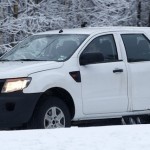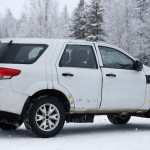
Are these seven-seaters prototypes of the SUV that will replace the Ford Territory when Ford Australia closes its Melbourne assembly and engine plants in 2016?
They are hybrids of sorts – although not as the motor industry knows it. They were pictured testing in the snows of Scandanavia by photographers from spy agency Automedia. (automotivenews.co.nz has the sole NZ rights to Automedia’s material).
The prototypes clearly have Ranger roots. From the front seats forward it is all Ranger; from the second row of seats back it is all Territory, providing a clue to a future platform for Ford SUV buyers.
The rudimentary joining of the two vehicles is obvious in many places. For instance, the window line in the rear doors is lower than those of the front. So are the door handles.
Automedia says the prototypes’ rear suspension was covered up to disguise a likely coil-spring set-up, again for an improved SUV ride over the leaf-spring Ranger pick-up.
A Ranger pick-up/SUV range was talked about long before Ford Australia confirmed Territory production would end along with the Falcon sedan and ute in 2016.
The core of the global “One Ford’ plan is based on making money from as fewer platforms as possible, for example, building six or eight vehicles off the one chassis.
The Ranger is a world vehicle assembled in a number of countries. New Zealand gets its from Thailand, along with many other rival models.
The latest Ranger pick-up has been hugely successful for Ford. Adding an SUV with the same name would rival the Colorado pick-up and seven-seat SUV from General Motors-Holden, keeping the long-time competition between the two alive after they both exit Australia. (GM-Holden shuts down production in 2017).
Ford Australia is already winding down its operations, leading to speculation that it will go before October 2016. From this June it will cut vehicle production at its assembly plant in Melbourne to between 80 and 90 vehicles a day.
Last year it was building 149 vehicles a day; the year before it was 209. In 2006 it was 450 cars a day, or 65 an hour. Ford Australia communications director Wes Sherwood told reporters across the ditch that early sales in 2014 continued to reflect weak demand for large Australian-built vehicles.
“We plan to manufacture our vehicles until October 2016 – that is still our plan – but if there are some sort of major disruptions across our operations or something in the market, then we may have to go back and re-evaluate our plans,” he said.




